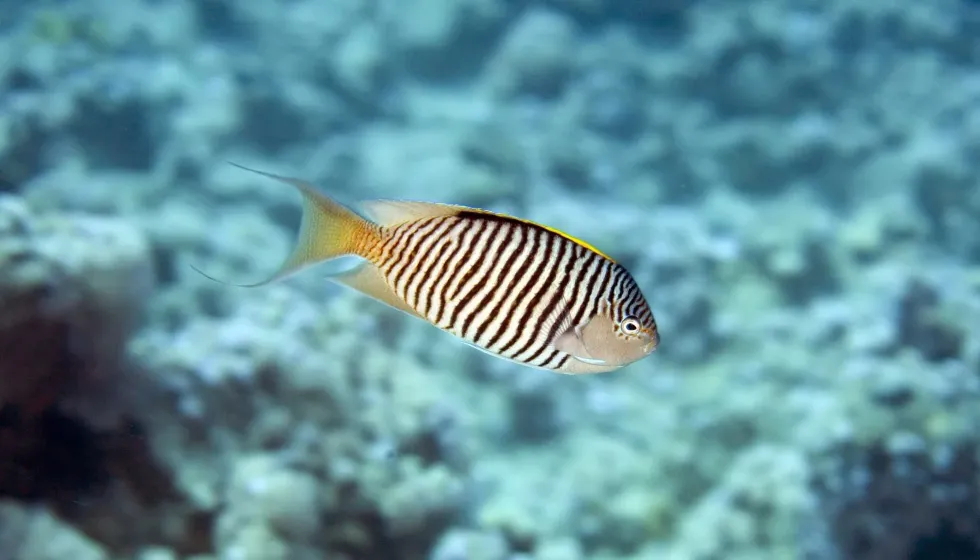Did you know that Zebra Angelfish live in female-majority packs? There is only one male among them and he is responsible for leading the group. When this angelfish dies, one of the female fishes starts changing color and transforms into a male. Yes, that’s right. This way the group continues to have a leader.
Zebra Angelfish is a freshwater angelfish most commonly found in the Red Sea and the Indian Ocean. Scientifically known as Genicanthus caudovittatus, they stand out because of the vertical stripes on their bodies, very much like a zebra.
This species is a part of the cichlid family. Their tail fins are in the shape of a fork and their body shape is round.
This species is generally very peaceful but males become territorial with each other and need their own space to live peacefully. When it comes to spawning, their behavior towards each other is very aggressive.
If you like reading about different kinds of animals, you can check out our articles on the fathead minnow and rainbow trout.
Zebra Angelfish Interesting Facts
What type of animal is a Zebra Angelfish?
It is a type of fish.
What class of animal does a Zebra Angelfish belong to?
The Zebra Angelfish belongs to the Actinopterygii class. It belongs to the fish species.
How many Zebra Angelfishes are there in the world?
The exact number of these fish in the world is unknown. However, they must be in abundance because they fall under the Least Concern category in the IUCN Red List.
Where does a Zebra Angelfish live?
The species has been sighted in several places. It is most commonly found in the Red Sea, the western side of the Indian Ocean, and the KwaZulu-Natal in South Africa. It can also be found in Weh Island which is a part of Indonesia.
What is a Zebra Angelfish's habitat?
These angels live in coral reefs. Juvenile fish go as deep as 60m as compared to angels who may swim at a depth of 98 ft (30 m).
Who do Zebra Angelfishes live with?
Unlike other fish who live in pairs, Zebra Angelfish live in packs. These packs typically contain only one male who is the leader of the group and the rest are females.
When he dies, the dominant female fish transforms into a male and takes his place as the leader of the group. This way, there's always someone to lead the little community of angels.
How long does a Zebra Angelfish live?
These angels typically have a life span of up to 15 years.
How do they reproduce?
The male angelfish will pair up with one of the female angelfish from the group for breeding. Because they live in packs, angelfishes may get a little aggressive when the time for spawning comes. For example, the male blue zebra angelfish will try to shove the other fish away when he wants to breed.
Then he and the female angelfish swim together until she lays eggs. Following which the male zebra angelfish will release sperms and fertilization will take place. Sometimes, Angelfish may eat their own eggs.
If they don't eat their eggs, Angelfish keep an eye on their eggs until they hatch and start floating in the water. They start developing over the next few weeks and transform into small fish, also known as, fry. Young fish can usually be seen swimming in deeper waters when compared to their adult counterparts.
What is their conservation status?
The conservation status of this species is Least Concern. This means that this particular fish breed is not in danger and humans don't need to worry about them. In addition, many protected areas are home to this fish and they are even bred in aquariums.
Zebra Angelfish Fun Facts
What do Zebra Angelfishes look like?
Just as the name implies, Zebra Angelfishes have black stripes on their bodies. These fish have a small mouth and a long tail that resembles a fork.
A person can identify their gender because of the difference in color and markings. The male fish is bluish-white and is covered with dark stripes. The females are pinkish-gray and a dark patch surrounds their eyes.
In addition, they have black stripes on the edges of their caudal fin. These fish are a type of bony fish. These fish not only have spines but also have soft rays.
Their dorsal fin, which is their top fin, has a total number of 15 spines as compared to their anal fin which has as few as three spines only. However, these three spines are assisted by a total of 17-19 soft rays.

How cute are they?
People are drawn to this fish because of their black stripes which give them a striking appearance. The black bands and stripes on their bodies make them look rather cute. Like other angelfishes, this particular species is also stored in aquariums.
How do they communicate?
Freshwater Angelfish (Pterophyllum scalare) most commonly communicate through body movements shaking and fluttering. This is most apparent when they want to mate with each other. Males will move closer to a female fish to send a message. This pair will communicate by moving the length of their body.
How big is a Zebra Angelfish?
This fish has a length of 7.9 in (20 cm). Generally, male fish are bigger than their female counterparts.
Hence, it is no surprise that they are the ones to assert dominance out of the two. The exact freshwater zebra angelfish size is not known as of now.
They can be almost five times the size of a Leopard Wrasse which is only 1.9 in (5 cm) in size and almost five times smaller than the Tilefish which is 36 in (91.4 cm)
How fast can a Zebra Angelfish swim?
Generally, angelfish don't swim very fast. They are big in size and require a lot of space to move around. The exact swimming speed of these fish is not known but they swim slowly.
How much does a Zebra Angelfish weigh?
As of now, the weight of this species is not known.
What are the male and female names of the species?
Male and female Zebra Angelfish are known by the same name. People can easily identify their gender because of the difference in their color and stripes.
What would you call a baby Zebra Angelfish?
A baby angel does not have a special name. Generally, a baby fish is known as fry.
What do they eat?
Their diet consists of zooplankton which are tiny organisms found in water bodies. These specimens also tend to feast on things like algae. Those residing in tanks can be fed fresh, live, or freeze-dried foods. This fish is attacked by larger fish and sharks.
Are they dangerous?
This species is generally a peaceful breed. Male angelfish tend to compete with each other and may act aggressively towards other fish in the tank when it's time to breed and act very territorial. Sometimes, they may eat smaller fish.
Would they make a good pet?
If you want to keep them as a pet, then make sure that you buy a tank that gives them a comfortable amount of space to swim. The Silver Zebra Angelfish, which originates from South America, in particular, prefers an aquarium filled with rocks and hardy plants.
The tank mates of an angelfish should be similar in size because if they're too big, they might end up eating the fish or if they're too small then the Zebra Angelfish might see them as prey. The aquarium should be big enough to hold 55 gallons (208.1 l) of water or more if needed.
Unlike koi, Angelfish is better suited to warm water temperatures between the range of 78-84 F (25.5-28.8 C).
Suitable water conditions and temperature must be maintained for these angels. Angels generally live in a community of six.
People who keep this angelfish as their pet must monitor the aquarium regularly and take special care of the community of angels, especially when it's time for them to breed.
Generally, a male angelfish may start spending more time with one of the female angelfish from the group. This is one sign that this pair is planning to mate soon and may need more space for the same in the future.
Soon, the female angel will lay eggs (sometimes on plants) and the parents will keep a close eye on these eggs.
Did you know...
In addition, there are many other types of angels. Unlike the Zebra Angelfish which has black stripes and a bluish-white coloration, Black Zebra Angelfish not only has black stripes but is also black in color.
Another type of angelfish is the Pinoy Blue Zebra Angelfish which like the name suggests has an attractive blue coloration. This fish is alternatively known as Philippine Blue Zebra Angelfish.
Another fish with blue coloration is the Zebra Blue Angelfish. There is also the Multicolor Angelfish.
Some angelfish can be very rare such as the Black Phantom Angelfish which looks striking with its black body, a yellow pattern around its mouth, and a yellow tail. Angels aren't necessarily big, with the smallest angel called Leopoldi being less than 2 in (5 cm).
How did Zebra Angelfish get their name?
They get their name due to the nature of their black stripes which are most commonly seen in zebras.
What adaptations do Zebra Angelfishes have?
As mentioned earlier, this freshwater Angelfish has several fins which allow it to swim. Their bodies are round and they just have one dorsal fin, unlike other fish which may have several dorsal fins. The vertical stripes on their bodies give them a distinctive look.
Here at Kidadl, we have carefully created lots of interesting family-friendly fish facts for everyone to discover! Learn more about some other fish from our Sunfish facts and Arctic Char fun facts pages.
You can even occupy yourself at home by coloring in one of our free printable Zebra Angelfish coloring pages.










